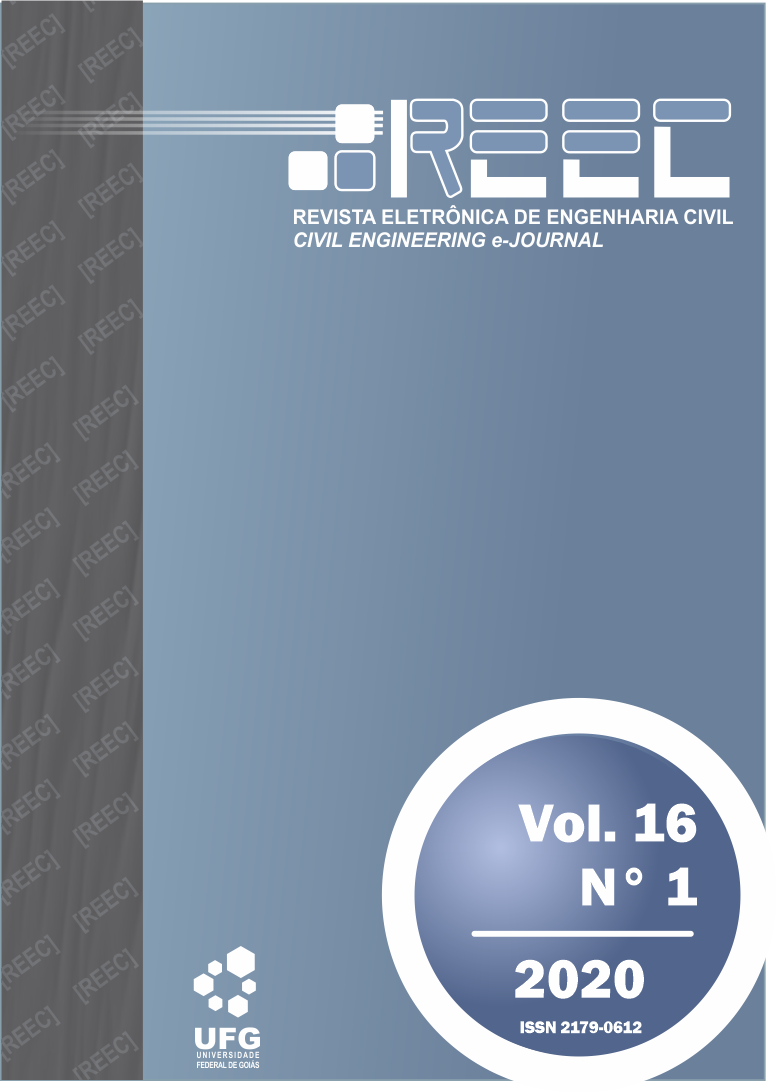VIGAS DE CONCRETO REFORÇADO COM FIBRAS DE AÇO SUBMETIDAS À FLEXÃO
DOI:
https://doi.org/10.5216/reec.v16i1.50551Resumo
RESUMO: O presente trabalho compara experimentalmente os resultados de ensaios à flexão a quatro pontos de vigas de concreto com e sem adição de fibras de aço. O objetivo principal do trabalho foi analisar as influências que as fibras de aço tendem em modificar o surgimento de patologias relacionadas à fissuração do concreto. Este trabalho se justifica pelo fato de que a implementação de elementos de reforço ao esforço de flexão não é amplamente explorada no Brasil, mesmo tendo ocorrido um crescimento considerável nas últimas décadas. Vigas com adição de fibras não é um método totalmente difundido no Brasil, entretanto pisos de concreto e lajes reforçados com fibras já são mais usuais nas construções do país Para análise do comportamento à flexão foram realizados ensaios de laboratório com oito corpos de prova, moldados com e sem fibras, a maioria com entalhe induzindo a propagação vertical da fissura na região central da viga. Foi utilizado um baixo teor de fibras de aço (0,25%) para não implicar na trabalhabilidade do concreto e, com isso, testar um material que pode ser confeccionado em situações usuais da construção civil. Para o teor de fibras estudado observou-se um acréscimo de 26,6% no valor da carga máxima atingida. Outro fator relevante foi que não houve dificuldades em relação a trabalhabilidade do concreto quando adicionado as fibras. Os resultados obtidos sobre a resistência comprovaram eficiência quando se usou as fibras no ensaio a flexão.
ABSTRACT: The present work compares the results experimentally of four-point bending tests of concrete beams with and without addition of steel fibers. The main objective of this work was to analyze the influence of steel fibers in modifying the appearance of pathologies related to concrete cracking. This work is justified by the fact that the implementation of reinforcement elements to the flexion effort is not widely explored in Brazil, even though there has been a considerable growth in the last decades. Beams with addition of steel fibers are not method used in Brazil, however, concrete floors and fiber-reinforced slabs are more common in the country's constructions. For bending behavior analysis, laboratory tests were performed with eight test specimens, molded with and without fibers, most of them with notch, inducing vertical propagation of the crack in the central region of the beam. It was use of a low content of steel fibers (0,25%) to avoid the workability of the concrete and, with this, to test a material that can be made in usual civil construction situations. For the fiber content studied, there an increase of 26,6% in the maximum load value. Another relevant factor was that there were no difficulties in relation to the workability of the concrete when added the fibers. The results obtained on the resistance proved efficiency when the fibers were used in the bending test.
Downloads
Downloads
Publicado
Como Citar
Edição
Seção
Licença
Autores que publicam nesta revista concordam com os seguintes termos: Autores mantém os direitos autorais e concedem à revista o direito de primeira publicação, com o trabalho simultaneamente licenciado sob a Licença Creative Commons Attribution que permite o compartilhamento do trabalho com reconhecimento da autoria e publicação inicial nesta revista.
![[REEC] Revista Eletrônica de Engenharia Civil](https://revistas.ufg.br/public/journals/30/pageHeaderLogoImage_pt_BR.png)



